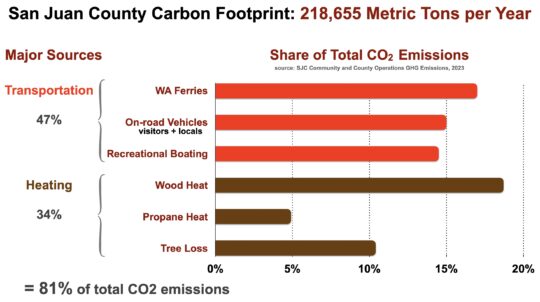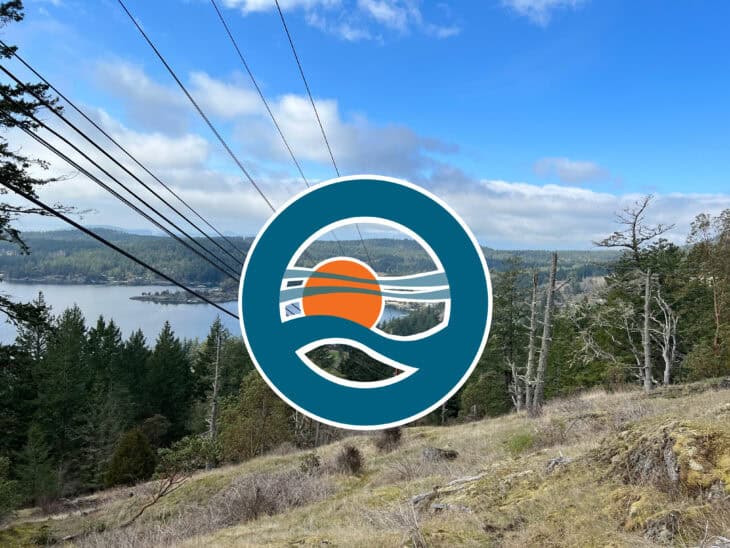Climate Action in San Juan County
Astronaut and Orcas Islander Bill Anders said, “If the earth were the size of an apple, the atmosphere would be the thickness of the apple’s skin.”
The picture on the cover, taken from the International Space Station, gives us a feel for how thin and fragile Earth’s gossamer atmospheric veil is.
For millennia, Earth’s moderate surface temperature has provided a hospitable environment for humans and millions of plant and animal species to thrive.
But with the advent of the industrial age, especially after World War II, burning fossil fuels ignited a life-threatening global warming chain reaction—putting millions of species at risk of extinction, melting glaciers, extreme rain and flooding, sea level rise and shoreline erosion, ocean heating and acidification, droughts, wildfires, climate refugees, and so much more.
Think Global, Act Local
Burning fossil fuels releases greenhouse gases containing carbon dioxide, methane, and other pollutants that can persist in the atmosphere for over 500 years. These emissions increase the “greenhouse effect” by trapping heat and warming the planet more than one hundred times faster than historical norms.
To restore planetary wellness, the global community has ramped up climate actions to reduce emissions and reverse climate destruction.
Twelve years ago, thinking about the largest greenhouse gas sources in San Juan County, OPALCO Board President Vince Dauciunas sketched a “back-of-the-envelope” estimate of the county’s emissions. Drawing on county fossil fuel usage, census, and economic data, he estimated that most of the emissions came from just two sources: transportation (cars, ferries) and heating (propane, fuel oil, and wood burning).
OPALCO’s estimate affirmed an emerging global climate science consensus to switch fossil-fueled transportation and heating to clean, renewable energy sources. This fuel-switching can:
- Reduce fossil fuel consumption and associated pollution.
- Increase electric consumption.
- Increase the efficiency of driving and heating. Electric vehicles (EVs) and modern heat pump heaters are three to five times more efficient than their fossil-fueled counterparts.
- Reduce typical household TOTAL (gasoline, propane, and electric) energy bills by about $2,000 per year – thanks to the efficiency and low operating cost of EVs and heat pumps.
Washington State became an early climate action leader. The State instituted a series of legislative, policy, and grant initiatives. These actions are aimed at getting carbon out of state energy systems, accelerating state and county-level climate planning, and investing in critical technologies and programs to spur renewable energy innovation.
The chart below shows Washington’s emissions over time, with history in blue on the left and future limits in orange on the right. It also lists major climate policies from 2020 through 2025.
![]()
Washington has grown almost 24% since 2005. Despite that growth, the state’s greenhouse gas emissions have held relatively steady. Reducing emissions by 45% by 2030 is a heavy lift. It can’t be achieved with “business as usual.” It will take massive investments in new infrastructure and innovative technologies.
With the passage of federal Infrastructure and Inflation Reduction Acts, billions of dollars of grant funding have started flowing to the states and counties to support these climate action initiatives.
These global, national, and state initiatives are driving key OPALCO actions, including:
- Increasing local energy efficiency and conservation programs to reduce energy waste.
- Increasing the capacity of the grid to support larger loads from electric cars, trucks, ferries, and heating. OPALCO can do this by using heavier distribution cables and adding a third submarine cable from the mainland.
- Increasing local generation to meet the growing load and provide climate resilience. This means building local solar and battery microgrids to ensure safe, reliable energy during the projected increase in mainland power outages.
- Utilizing applicable grants for innovative energy solutions and investing in the local infrastructure.
- Providing programs like Switch It Up, OPALCO’s on-bill financing program, to help co-op members improve efficiency, generate energy, drive and heat electric, reduce emissions, and save money.
County Climate Action
Last year, the county formed the Climate and Sustainability Advisory Committee to help accelerate climate action planning. Angela Broderick, the county’s Climate & Sustainability Coordinator, noted, “One of the first priorities identified was the completion of a Greenhouse Gas Emissions Inventory. This critical step established a baseline for us to understand our most significant sources of emissions and directed us on the path for planning targeted, effective climate action.”
The county inventory (see chart) confirmed OPALCO’s early estimates and added important detail:
- 47% of emissions come from transportation – relatively evenly split between ferries, vehicles (local and visitors), and recreational boating.
- 34% come from heating – wood heat, propane, and tree loss reduction of carbon sequestration.

This data can help the county prepare a climate action roadmap for decreasing pollution and increasing climate resilience. This includes developing a new, dedicated climate element for the San Juan County Comprehensive Plan and a Climate Action Plan (CAP) for implementation.
These early steps will provide a long-term vision, climate policies, and an implementation strategy for reducing emissions and preparing our community for current and future climate impacts.
San Juan County Council Member Jane Fuller underscores the importance of this work, saying, “The development of the forthcoming Comprehensive Plan Climate Element provides an opportunity for the county’s residents to gain a deeper understanding of the climate disruption we will be living with for some time to come. The Climate Action Plan will provide the foundation for the county to identify ways to become more resilient to climate changes and adapt to and mitigate its effects.”
County Climate Action Next Steps
Angela Broderick described some key next steps, “To create meaningful goals and policies for the climate element and a grounded, actionable plan, we need to understand our community members’ lived experiences, challenges, and hopes for the future. We’re planning an engagement campaign launching this spring and running through 2024 to connect via community conversations with a diverse set of San Juan County residents. This effort seeks to identify effective and equitable climate actions that will guide us to make smart and resilient investments that align with shared goals and enhance the well-being of the entire community. We need as many residents as possible to participate to make this a success!”
What we share is stronger than what we face
Reversing a century of pollution in a few short years is no small task. It will take all of us pulling on the rope together. There are no perfect solutions. No easy answers.
But there is hope. Every step we take together, no matter how big or small, helps.
Since greenhouse gas pollution, once emitted, remains for over 500 years. This is over 20 human generations. That’s our children’s, children’s, children’s, children’s, children’s, children’s, children’s, children’s, children’s, children’s, children’s, children’s, children’s, children’s, children’s, children’s, children’s, children’s, children’s, children.
Not to mention the generations of all Earth’s at-risk plant and animal species.
Support local energy, climate action, and participate in the numerous co-op and county climate outreach events this year. To learn more, visit www.opalco.com and https://engage.sanjuancountywa.gov/climate-action.



